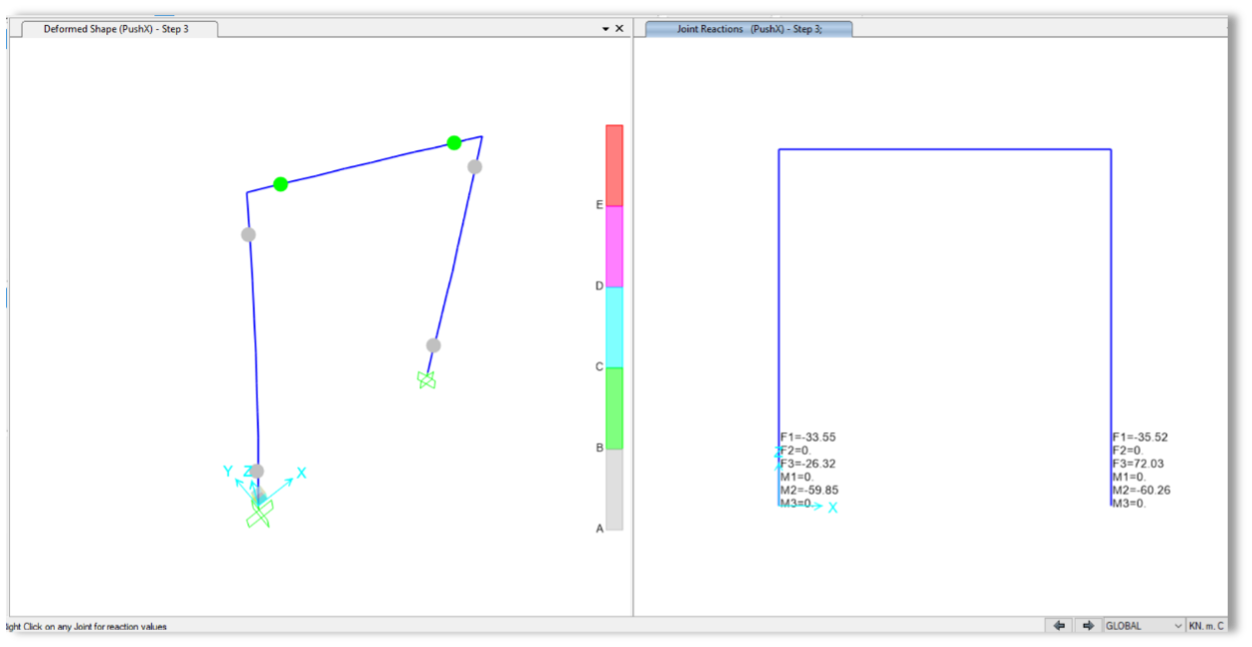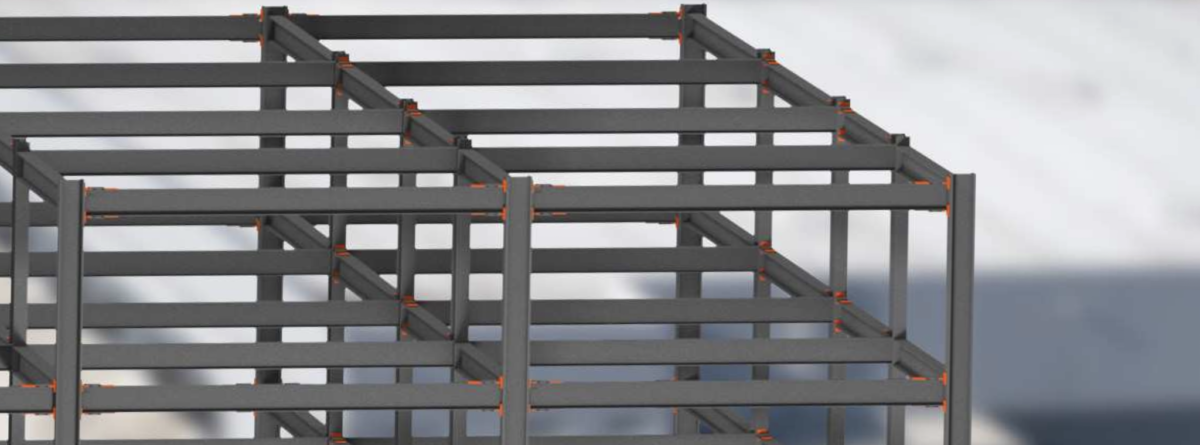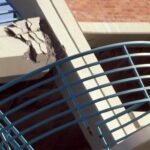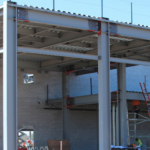Resiliency is a term which is becoming more commonplace within the field of structural engineering, not just in North America but worldwide. As part of a nation that prides itself on being progressive, engineers in seismic zones of Canada are already exploring innovative solutions that may help create economic structures with resiliency in mind. But what do we mean by resiliency?
In the fields of engineering and construction, resiliency is the ability of a structure to absorb or avoid damage without suffering complete failure. Structural resiliency is the ability of a building or structure to remain sufficiently sound and intact following a shock event as to allow rapid resumption of normal use.
Certain high-seismic zones of the US, such as California, are already taking the steps necessary to incentivize resiliency in the design of their structures. Simpson Strong-Tie has stayed ahead of this trend with our Yield-Link®moment connection for steel construction (see Figure 1). This connection uses our patented Yield-Link structural fuse technology to mitigate damage to beams and columns during seismic events. These bolt-on, bolt-off replaceable structural fuse elements help to create a resilient structure that ensures the building functions after a major earthquake. This is an improvement over other CISC prequalified moment connections for seismic applications, which are specifically designed to damage the beams when dissipating seismic energy. Current seismic design principles create disposable building designs that are safe and acceptable for code compliance, but not designed to function after an earthquake.
With the Canada-wide launch of the Yield-Link® moment connections, the engineering and software development teams at Simpson Strong-Tie have created new versions of our literature and design tools to support Canadian users in their specification of the Yield-Link moment connections. Below is a summary of the specifics pertaining to our Canadian literature, design tools and engineering services for projects in the great white north.

Yield-Link Moment Connection Benefits and Applications in Canada
I’ve already mentioned that the Yield-Link moment connections help create a resilient structure by utilizing easily replaceable structural fuses, but there are many additional benefits for designers, fabricators, and owners. Consider the following:
- The field-bolted Yield-Link moment connection reduces construction schedule by offering huge time savings in the fabrication/erection process over fully welded connections.
- Yield-Link moment connections offer extensive cost savings down the line for the owner; as well as peace of mind which comes with knowing that the structure can be easily repaired in the event of a major earthquake.
- Yield-Link moment connections are code listed under ICC-ES ESR-2802 — ICC is accredited as a product certification body under the SCC (Standards Council of Canada).
- Yield-Link moment connections are backed by full-scale physical testing that meets all of the qualification testing provisions listed in Annex J of CSA S16.
- Simpson Strong-Tie has developed free design tools according to Canadian CSA/NBC codes and standards, as well as shop drawing tools for fabricators to simplify the detailing process.
- Simpson Strong-Tie is also offering to provide engineers with the sealed design of the Yield-Link moment connections for free for projects within Canada.
Since Yield-Link moment connections are designed to yield during a major earthquake and be easily replaceable, they are intended for use in Type LD, MD, and D moment frames in areas where seismic forces govern the design. These types of moment frames allow engineers to drastically reduce lateral earthquake force in their designs by taking advantage of the high ductility of the systems. This can lead to a more economical frame design over conventional construction moment frames, which have very low ductility and are designed to remain elastic for much higher earthquake forces. Refer to Figure 2 below for the differences between the types of moment frames in Canada.

In addition to serving as a more economical moment frame option in high seismic regions of Canada, ductile moment frames are either required by code or offer greater advantages over conventional construction in a number of applications. These include the following:
- In wood buildings/houses utilizing nailed shearwalls to resist lateral seismic loads, where one or more moment frames are required to frame out large openings in the walls. According to Table 4.1.8.9 of Part 4 of the NBC, nailed shearwalls have nearly identical RdRo values to Type MD steel moment frames. Since the NBC also tells us that RdRo shall be taken as the lowest value for combinations of different types of SFRS, in this case utilizing a Type MD moment frame allows the designer to take full advantage of the higher ductility of nailed shearwalls without the need to reduce RdRo values in the earthquake force calculation. This leads to not only a lighter steel moment frame, but lighter wood shearwalls and anchor tiedowns.
- In post-disaster category buildings such as hospitals, fire halls, and wastewater treatment plants where Type LD moment frames are commonly utilized. The NBC prohibits the use of conventional construction steel frames in buildings falling under the post-disaster category and sets the minimum required Rd value of 2.0 for the SFRS. This requirement can be satisfied with the use of a Type LD moment frame for which the Yield-Link moment connection is a great solution.
- In any buildings where conventional construction steel frames are limited by height restrictions according to NBC Table 4.1.8.9. In these cases, Type MD and D moment frames can be designed since they are permitted for use at any height, in any region of Canada.
The free design tools which Simpson Strong-Tie offers to engineers can be used to quickly and easily design the entire frame, and not just the Yield-Link moment connections. So we encourage Canadian designers to take advantage of these free tools and explore ductile moment frames as an option wherever seismic forces govern their design.
Canadian Literature and Design Tools
Both our connection modeling and design guides are available to assist engineers with specifying Yield-Link technology. The Canadian versions of the guides can be identified by the red maple leaf logo on the front covers (see Figure 3 above). Either guide can be downloaded below:
Download: Yield-Link Moment Connection Modeling Guide
Download: Yield-Link Moment Connection Design Guide
The Yield-Link Moment Connection Modeling Guide covers three different options for the engineer to model the Yield-Link moment connection as a partially restrained connection in any structural analysis software. Within the guide, engineers can find an overview of our free ETABS and SAP2000 plugins, which are the simplest and easiest way to model our connections. For engineers who don’t have access to ETABS or SAP2000, the guide covers how to place a partial rotational fixity near the ends of beam members. Finally, for engineers who do not have access to software capable of modeling partially restrained connections, the guide offers a solution following the “Equivalent Elastic Link Element” approach. Designers can also find a convenient chart to assist with preliminary link selection in this guide.
The Yield-Link Moment Connection Design Guide takes a deep dive into the Canadian codes and the engineering principles behind the design of the connections and ductile moment frames in general. This guide covers the history of ductile moment frame development, design requirements and considerations for ductile moment frames, and Yield-Link connection design principles. This guide also lists all the advantages of the Yield-Link moment connections from the perspective of various project stakeholders, as well as a step-by-step summary of the engagement process to ensure the Yield-Links are implemented smoothly on any project.
Our fully integrated ETABS and SAP2000 plugins are the simplest and easiest ways to model and design the Yield-Link moment connections. These free plugins allow engineers to design not only the moment connections but the entire moment frame entirely within ETABS or SAP2000. The plugins automatically model the connections as partial releases and perform all of the complicated code calculations associated with ductile moment frame design. These plugins are perfect for larger buildings where 3D modelling is required or where P-Delta forces are expected to impact the design. Since the plugins are fully integrated with ETABS and SAP2000, they use the software’s engine to run the analysis and perform code checks. This means that the plugins are only limited by the capabilities of the version of ETABS or SAP2000 software the engineer is running.
Yield-Link Moment Connection Design Tool: Connection Design Excel Spreadsheet
For engineers who do not have access to SAP2000/ETABS, or for smaller projects where 3D modeling is not essential, the connection design Excel spreadsheet is the perfect tool. This tool performs all of the same functions as the ETABS and SAP2000 plugins, but uses Excel to perform the frame analysis and code checks associated with ductile moment frame design. The spreadsheet also has the ability to export all of the information into a full model of your frame in either RISA-3D, SAP2000, or S-Frame software. One of the limitations of the Excel tool when compared to our plugins is that it currently does not account for P-Delta effects. For this reason, any pink-colored cells in the Excel tool can be overwritten so the user isn’t limited to the spreadsheets analysis. The link to download either of our free plugin tools or the connection design Excel spreadsheet can be followed here.
Yield-Link® Moment Connection Design Example
As a structural steel field engineer for Simpson Strong-Tie in Canada, I’ve had the opportunity to design Yield-Link moment connections for projects in high-seismic zones. Since I mentioned that Simpson Strong-Tie is offering to provide the sealed design of the Yield-Link moment connections for projects in Canada, I wanted to do a quick walk-through of what this process looks like.
One of the best applications for Type MD moment frames utilizing the Yield Link connection is in custom homes where they’re required to frame out large openings. In this example, Simpson Strong-Tie was asked to design the Yield-Link moment connections for a custom home on Vancouver Island. Vancouver Island is one of the most severe earthquake zones in Canada (see Figure 6), so the engineer chose to utilize the ductility of a Type MD moment frame to match the wood shearwalls in the home. The benefit to this is that there’s no need to reduce the RdRo values, which allows the engineer of record (EOR) to design both the moment frame and wood shearwalls for a much lower earthquake force. This results in a lighter and more economical design, while maintaining resilience by ensuring quick and easy repair of the Yield-Link moment connections.

The first step was to request a free-body diagram of the moment frame from the EOR. Please refer to Figure 7 for a sample free-body diagram to be provided by the EOR. This information enabled me to model the frame and design the Yield-Links in one of our free design tools. In this case, I decided to use our connection design Excel spreadsheet since the custom home did not require 3D modelling and P-Delta effects are not expected to impact the design.

The next step was to set up the frame in the Excel tool and apply all of the forces from the free-body diagram. I’m then ready to run the analysis and proceed through the design tabs (3–8) in the spreadsheet to complete the design of the entire frame, including Yield-Link moment connections. The design process is an iterative one that involves selecting the smallest link able to meet the demands of the system. Once this is done, I can use the Excel tool to generate very detailed elevation drawings of the moment frames to provide to the EOR (see Figure 8). These elevations include all the details of the Yield-Link moment connections, including any required continuity/doubler plates in the webs of the columns.

With the design of the moment frame and Yield-Links complete, I also need to provide the base reactions to the EOR so that they can design the anchorage and foundations. To do this, I use the Excel tool to generate a full model of the frame in SAP2000 and run a nonlinear pushover analysis (see Figure 9). This allows me to identify the point at which the Yield-Link moment connections have yielded to form plastic hinges and extract the base reactions at that point. I then provide a summary of the base reactions to the EOR.

Finally, I provide the EOR with a typical notes and details drawing for the Yield-Links which makes sense for the project (see Figure 10). In this case, most of the details were specific to wood-framing applications with no unnecessary information.

Once the fabricator receives the drawings, they will order the Yield-Links from Simpson Strong-Tie and I will get them familiar with the moment connections so they know what to expect. In my experience, fabricators love our moment connections because they’re able to take advantage of the time savings associated with fabricating and installing them as compared with welded moment connections.
Conclusion
Structural steel construction in Canada has been a relatively stagnant industry where standard practices and common methods are considered “tried and true.” It’s for this reason that many within the industry are reluctant to adopt new and innovative solutions. It’s natural for most of us, after all, to prefer conventional solutions and the sense of security they provide. Simpson Strong-Tie is taking the lead in stepping outside conventional thinking and putting our trusted reputation behind new innovations in structural steel such as our Yield-Link® moment connections.
At Simpson Strong-Tie, we pride ourselves on supporting engineering and construction by staying ahead of trends to provide innovative structural solutions. The Yield-Link moment connection is a shining example of this process at work. Though they are just the first solution under our structural steel line, we’re hard at work developing more innovative and resilient technologies which I cannot wait to talk about in the coming months. If you enjoyed this entry on the Yield-Link moment connections in Canada, please check back for more blogs on exciting new solutions in the near future.









